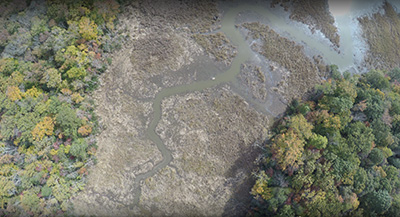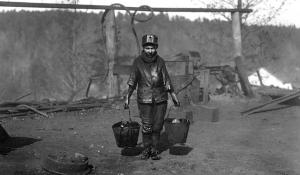
In the beginning, a woman fell from the sky, clutching seeds and fruits. The animals helped her find safety on the back of a turtle and brought her mud, from which she grew the seeds and fruits into a wilderness. In these moments together, the animals and Skywoman created Turtle Island, later named North America by European colonists.
This creation story, shared among many tribes in the Great Lakes region, as told by Robin Wall Kimmerer in her book, Braiding Sweetgrass, reflects the relationship Native tribes have shared with the land for countless generations—and one that was stolen from millions of people when colonists crossed the ocean and forcibly removed Native tribes from their lands. And while returning land back to Native peoples is a moral imperative, there are economic and environmental benefits that would come with doing the right thing.
Today, that movement is called Land Back, and is about putting Indigenous lands in Indigenous hands. Krystal Two Bulls (Oglala Lakota, Northern Cheyenne), the director of NDN Collective’s Landback campaign, says that reclaiming land is part of a bigger movement.
“It’s the reclamation of our kinship systems, our governance systems, our ceremony and spirituality, our language, our culture, our food systems, our housing, our health care…those are all based on our relationship to the land,” says Two Bulls. “The land provides for us and is a life source for us.”
From the Black Hills to the Amazon Basin
In 1868, the US entered a treaty with the Great Sioux Nation that designated the Black Hills, spanning 1.2 million acres in western South Dakota and northeastern Wyoming, as “unceded Indian Territory” to be used exclusively by Indigenous peoples. But when Lieut. Col. Custer led an expedition to investigate rumors of gold deposits in the Black hills and found it, the US government violated the treaty to seize the gold. That led to the deadly Battle of Little Bighorn as Custer violently drove out Indigenous communities. Over a century later, the US Supreme Court awarded $100 million in reparations, but the Sioux Nation refused—the land was never for sale to begin with, and what is owed is not a monetary sum, but the land back.
Beyond the legal obligation to honor the treaty, there are economic benefits to honoring treaties. Helen Ding, a senior economist at World Resources Institute, published a report demonstrating just that.
The 2016 report titled Climate Benefits, Tenure Costs: The Economic Case for Securing Indigenous Land Rights, focuses on securing Indigenous land in Bolivia, Brazil, and Columbia, which collectively contain most of the Amazon Basin and is home to millions of Indigenous peoples. If these peoples could have secured land titles, the estimated benefits in ecosystem services—such as reduced pollution, erosion control, and carbon storage—could result in an estimated economic benefit of up to $119 billion for Bolivia, $1.2 billion for Brazil, and $277 billion for Colombia over a 20-year period, according to that report. As a climate mitigation strategy, the cost of securing Indigenous land titles in the Amazon Basin is five to 42 times lower than the average cost of carbon capture and storage for coal- and gas-fired power plants.
When it gets down to the dollar, protecting Indigenous land rights makes economic sense.
“Moving away from land rights as a legal issue and helping people to understand that increasing land tenure security is essentially an economic matter and helps to reduce carbon emissions and protect forests,” Ding says.
Ding says that the biggest barrier to securing Indigenous land rights comes down to economic opportunity costs on the land. If a nation deems that oil, forestry, or gold on the land is more valuable than treaties, then they likely won’t honor land rights. This case played out in the Black Hills during the 1800s.
“That whole area in the Black Hills has been a [gold and tourism] moneymaker for the US government and the state of South Dakota for hundreds of years now,” says Two Bulls. “The money made off those lands that we were removed from, our traditional territories, and by treaty, technically should go to the tribes.”
That is why Ding’s research team focused on the economic side; by demonstrating that respecting Indigenous land rights results in more long-term economic benefits than resource extraction proves that the better investment for governments is in Indigenous people.
Healing Happens on Ancestral Land
Settler colonialism has resulted in genocide, poverty, addiction, and much more harm to Native nations, which have the highest poverty rate among minorities according to Census data. Two Bulls states that the root of their ills comes from land theft; therefore, the solution is giving land back.
Across Turtle Island, Indigenous tribes are finding ways to return home. In 2020, the Esselen Tribe was returned nearly 1,200 acres of their ancestral lands near Big Sur, California, after 250 years. In late 2021, the Squaxin Island Tribe was gifted over a thousand acres of land near the southern Puget Sound in Washington. In April 2022, 465 acres in the Chesapeake Bay was donated to the Rappahannock Tribe.

These stories are examples of land back. While there are many ways in which land can return to Native hands, such as a land purchase or a trust, the 465 acres given to the Rappahannock was the result of collaboration between the tribe and the Chesapeake Conservancy. The Conservancy managed a massive fundraising effort to purchase the land to donate to the tribe. While 465 acres is a small fraction of the Rappahannock’s original territory, it is a step in the right direction.
“It has been a long journey for the tribe’s restoration to the lands of our forefathers,” said Chief Anne Richardson of the Rappahannock Tribe during a celebration event. “To be able to reconnect with the DNA that is in the ground and on the cliffs.”
“There’s more work to do,” says Joel Dunn, CEO of the Chesapeake Conservancy. “There’s more land to protect along this beautiful river. There’s more land that we can buy for the tribe.”
With that land, the Rappahannock Tribe will be able to reclaim their cultural ties and practices. Chief Richardson describes the land as the tribe’s “grocery store,” with more than 250 plant and animal species the tribe gathers for food, crafts, and medicinal purposes. The environmental stewardship the tribe promises to practice—including developing an Indigenous conservation education center to teach future generations—will help restore the wetlands and help declining species make a return.
“When we reclaim lands, it opens up economic opportunities for us to be able to have revenue streams that are able to address the issues in our communities,” says Two Bulls. Tourism is one such revenue stream, says Two Bulls, noting that NDN Collective’s Land Back campaign currently has a focus on public lands like national parks and monuments.
“The root of [the word] ‘economy’ means taking care of your home,” says Two Bulls. “We’re not trying to reclaim land ownership in a Western colonial way of thinking about it. We are trying to reclaim our ways of being, which was never based on money.”
And while giving land back creates economic and environmental incentives, it also means giving Indigenous peoples the means to care for themselves and their communities again through their relationship with the land. ✺







